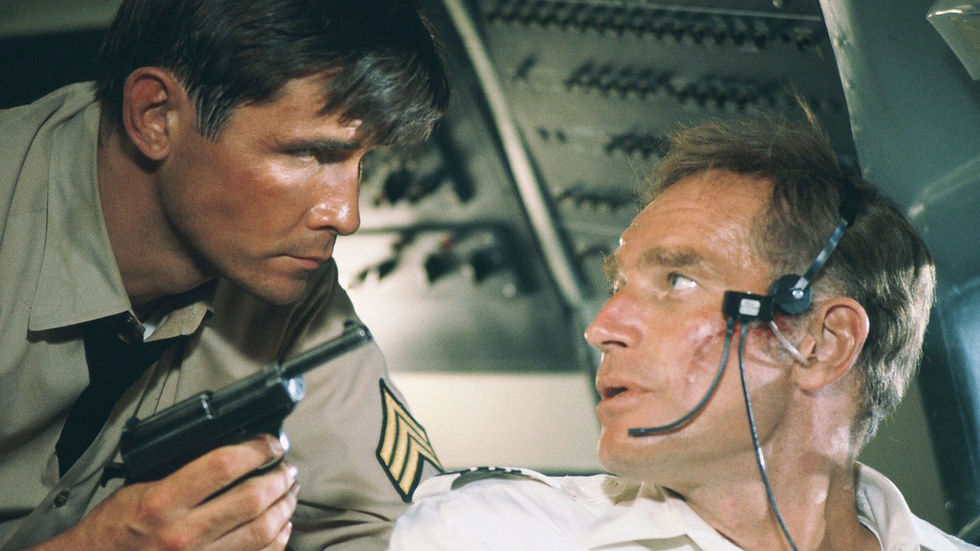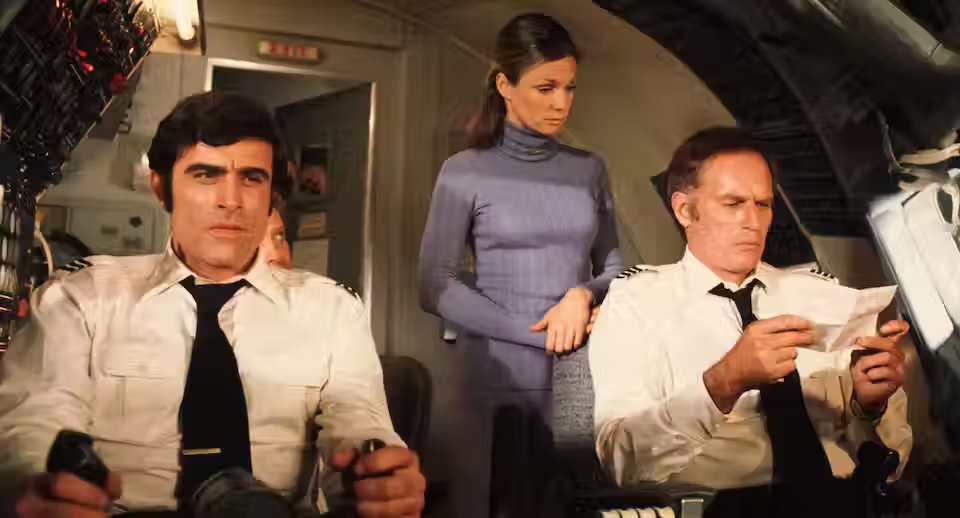Skyjacked (1972)
- Soames Inscker

- May 20
- 5 min read
Updated: Jun 8

In the golden age of 1970s disaster films—where ordinary people faced extraordinary circumstances—Skyjacked (1972) soared into theatres as one of the earlier examples of aviation thrillers that would culminate in genre landmarks like Airport (1970) and Airport '75. Directed by John Guillermin (later known for The Towering Inferno and the 1976 King Kong remake), Skyjacked blends Cold War paranoia, claustrophobic suspense, and an ensemble drama format into a tense, if occasionally formulaic, high-altitude thriller.
Plot Overview
The film takes place almost entirely aboard a commercial Boeing 707, Trans Global Airlines Flight 502, enroute from Minneapolis to Anchorage. The flight, captained by Hank O'Hara (Charlton Heston), seems routine until a note is found in the lavatory, written in lipstick: “Bomb on plane. Divert to Anchorage. No joke.”
The crew and passengers are shaken, and the pilot must quietly navigate a potential crisis without causing a panic. The message proves real enough to divert the plane to Anchorage. But as authorities and bomb squads search the aircraft and fail to find a device, the tension remains. The second note reveals a shocking twist: “Not Anchorage. Moscow.”
A hijacking is underway—and the perpetrator is already on board.
It is eventually revealed that the hijacker is Sgt. Jerome K. Weber (James Brolin), a psychologically unhinged Vietnam veteran with delusions of grandeur and a fervent belief that he will be welcomed in the Soviet Union as a hero. With a loaded weapon, a hidden bomb, and a twisted sense of political purpose, Weber demands the plane be rerouted to Moscow. Captain O’Hara must find a way to protect his crew and passengers while navigating treacherous skies—both literal and ideological.
Performances

Charlton Heston, as the stoic and authoritative Captain Hank O’Hara, is very much in his wheelhouse. A veteran of high-stakes leadership roles (El Cid, Planet of the Apes, Airport 1975), Heston brings gravitas and controlled tension to the part. His performance is understated but effective—his ability to command a room (or cockpit) never in doubt. While his character is more functional than emotionally nuanced, Heston grounds the film with calm professionalism.
James Brolin, in a surprising and uncharacteristically intense role, is the standout. His portrayal of Sgt. Weber is a mix of damaged patriotism, paranoia, and seething resentment. He effectively embodies the post-Vietnam disillusionment and psychological trauma that haunted a generation of American soldiers. Brolin manages to keep the character from tipping into caricature by showing hints of pathos and instability rather than cartoonish villainy.
Yvette Mimieux, as stewardess Angela, plays the sympathetic and quietly resourceful flight attendant caught between her duties and growing affection for the captain. Her role is emblematic of how women were often written in 1970s thrillers—nurturing, supportive, and only occasionally active in the plot—but Mimieux brings warmth and realism to the part.
The supporting cast includes genre stalwarts and familiar faces:
Walter Pidgeon, in a brief but dignified role as a senator;
Susan Dey (of The Partridge Family), as a pregnant passenger;
Claude Akins, as the plane’s first officer, offering reliable support and grounded-ness.
Each character aboard the plane serves a function in the ensemble structure—providing a cross-section of American society under stress.
Direction and Pacing
John Guillermin, known for his no-nonsense direction, keeps the pacing tight and the tension taut. Much of the film’s success lies in its containment—it largely takes place in the narrow confines of the airplane, amplifying the claustrophobia and the stakes. Guillermin emphasizes the tension not through constant action but through escalating dread: hushed conversations, slow reveals, and growing unease among the passengers.
While Skyjacked is less stylized or grandiose than later disaster films, it thrives on atmosphere and urgency. The tension builds steadily, particularly as Weber's true motives are revealed and the flight moves into Soviet airspace.
Themes and Subtext
Unlike the disaster movies that followed, which leaned more into spectacle and star-studded chaos, Skyjacked injects a dose of Cold War anxiety and post-Vietnam disillusionment into its narrative. Sgt. Weber is not just a madman—he’s a deeply symbolic figure of a fraying American psyche, a soldier cast aside and consumed by paranoia and betrayal. His choice of Moscow as a destination is not just geographical but ideological, serving as a dark twist on Cold War allegiances.
The film also subtly critiques the romanticization of war heroes, suggesting that not all veterans return home with their minds intact, and not all receive the help they need. While the handling is not as nuanced as later films on the subject, it was a notable inclusion for its time.
There’s also a running thread of institutional control vs. individual action, with Captain O’Hara representing calm, rational leadership amid bureaucratic indecision and personal instability.
Cinematography and Score

The cinematography by Harry Stradling Jr. makes good use of the enclosed aircraft interiors, capturing both the technical claustrophobia and the psychological tension. The plane itself becomes a kind of pressure cooker. In-flight sequences are handled convincingly, especially given the limitations of the time and budget.
The score by David Shire adds a noir-ish edge, enhancing the suspense without overwhelming the drama. It's not a bombastic or memorable soundtrack, but it's effective in reinforcing the film’s restrained style.
Criticism and Limitations
Skyjacked suffers from some of the limitations of its era and genre. Some of the characters, particularly the female passengers and crew, are underdeveloped. The dialogue occasionally dips into melodrama or dated stereotypes, and the climax—while suspenseful—lacks the visual impact of later films in the genre.
Additionally, while the film tries to address complex political and psychological issues, it sometimes reduces them to thriller tropes. Sgt. Weber, while chilling and compelling, could have been a more tragic figure with a deeper exploration of his inner torment rather than defaulting to the “crazed veteran” archetype.
Legacy and Influence
Though not as widely remembered today as Airport or The Poseidon Adventure, Skyjacked holds an important place in the evolution of the disaster and hijacking subgenres. It preceded a wave of 1970s films that put ordinary civilians in peril aboard planes, trains, and ships. Its influence can be traced forward to everything from Airport 1975 to Executive Decision (1996) and even Flight plan (2005).
It’s also notable for giving James Brolin one of his earliest and most intense dramatic roles, and for offering Charlton Heston yet another showcase for his commanding screen presence in times of crisis.
Conclusion
Skyjacked is a taut, efficient thriller that blends suspenseful direction, Cold War unease, and post-Vietnam social commentary into a lean 100-minute ride. While not as bombastic or iconic as other disaster films of the decade, it delivers solid performances, particularly from Heston and Brolin, and sustains its tension with intelligence and restraint.
A suspenseful, well-executed hijacking thriller with a Cold War twist—more psychological than spectacular, but all the more effective for it.




